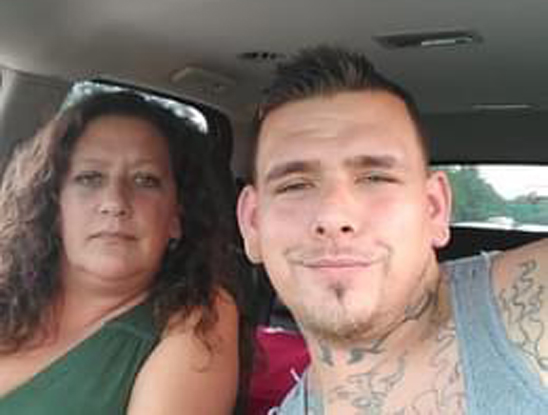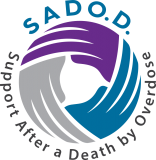
Bereaved Mother Finds Support, Becomes Peer Grief Specialist
By Luke Schmaltz, VOICES Newsletter Editor
Melissa Lezynski is a Peer Grief Support Specialist (PGSS) for SADOD. In her work she helps people who are bereaved by the death of a loved one to substance-use-related causes. She meets with them one-on-one and listens to their stories. She gives grieving people a safe place to open up and talk about the pain, anger, confusion, and stigma which has upended their lives. This work has allowed her to discover an important element of healing in her own grief journey.
Lezynski lost her son, Sean, to an overdose in August 2023. She is also in recovery, and has experienced first-hand the world of substance use, grief, family chaos, hope, connection, and newfound community.
A Great Kid
“Sean was quite a character,” Lezynski begins. “He was the perfect kid. He slept all night from day one and he never cried. He was in the middle between my older and younger daughters. When I was pregnant, Sean’s biological father and I got divorced. He got remarried right away and had his second son a day before Sean’s birthday. So, he wasn’t around at all. He moved to Missouri and Sean stayed here with me.”
“I hooked up with an ex-boyfriend whom I had known since I was 13. I was homeless at that age, and I met him at a gas station and moved in with him in November of 1984. Life happened and I didn’t see him again until I was pregnant. He was there when I had my son, whom I named after him. Little Sean grew up with Big Sean as the father figure. It worked out well until Big Sean’s mom passed when Little Sean was 11. He was close to her and used to visit her every weekend.”
A Ripple Effect
“That had a huge effect on all of us. Big Sean became somebody I didn’t even know. He was never right again – he was never quite whole again – and he went off the rails. He started using meth and would jump at an opportunity to act inappropriately. So, I wound up marrying someone else, whom I had been with for many years.”
“Little Sean was arrested for stealing a rubber ball from a toy store. His troubles escalated, and he was arrested for sinking the Gloucester Police Department’s boat. He wanted to be the badass criminal he thought Big Sean was. At the age of 14, he got locked up, ordered to serve a four-year sentence in a maximum-security prison in Dorchester. I tried to visit him every weekend. It was torture.”
“And then I found meth. I fell right in love with it. I couldn’t feel a thing, nothing, and that’s exactly what I wanted. It wasn’t long before the rest of life went to crap. My oldest daughter was already using heroin. She went from being a beautiful, normal, 18-year-old to selling herself on the streets for dope. From zero to 1,000 in no time. We never knew where she was – I would have gone to the ends of the earth to find her. All of my time was occupied by looking for her, trying to get her home and into treatment. So, I assumed Sean’s problem was that he wasn’t getting enough attention – she was taking it all up.”
Family Turmoil
“When he was released, he went to the Job Corps and got certified in masonry. He already had a kid by then from a girl he got pregnant just before he went to jail. Unfortunately, by the time he got out, she had married someone else, and he was devastated. She wouldn’t let him see the kid and wanted to keep it as simple as possible, but it didn’t turn out that way. My granddaughter was adopted three different times, but thankfully, she is in our lives regularly now.”
“Also, when he got out, his biological father showed up out of nowhere. He wanted Little Sean to visit him in Missouri. I begrudgingly let him go, and within a month he was smoking meth with his dad, they became running buddies. It took around six months to get him back here. He was emaciated, there was nothing left of him. We tried everything. He went on suboxone and methadone, and then Big Sean showed up and took him to Wisconsin, where he then became another running buddy. The house was raided, and Big Sean tried to put it on Little Sean. They got into a physical altercation, Little Sean called me crying and said, ‘I want to come home.’”
“I brought him home again and he mostly stayed with me. He would go back to Missouri for a girl, but that didn’t last long. His drug use had its effects on her too. They had two kids together, so he had four kids in total and was up to his eyeballs in child support. He couldn’t keep a job because he was never OK. He would get clean by going to rehab or sometimes by hospitalization. He was so charismatic and sweet, so nobody put the responsibility for his actions on him.”
The Bad with the Good
Her son’s death was an all-consuming event for Lezynski – mentally, physically, and spiritually. She describes intermittent waves of grief, anger, and a whirlwind of other emotions. “I didn’t think I would live through it,” she says. “I remember saying, ‘Sean if anything happens to you, I will perish. I won’t make it; you’ve got to get well.’ He would say, ‘Mom, I’m going to be fine, don’t worry, don’t cry.’ Then, he would do something ridiculous three seconds later. It made me so nuts. I worried constantly to the point where I was on blood pressure medication for 20 years.”
“The crazy thing was, when he died, I didn’t need the medication anymore. I thought I was dying but they did all the tests and said it was Broken Heart Syndrome, and that it would fix itself over time. But they couldn’t explain why my blood pressure was suddenly perfect.”
“When Sean died, my oldest was finally in long-term treatment. It was the first time she stayed anywhere besides jail. She had been there for four months. I thought when she found out about her brother, she would be out the door and I would be burying them both at the same time, but she didn’t leave treatment.”
Bittersweet Memories
“The worst thing that could ever happen came to pass. I’ve been through more things than most people will ever experience. The only thing that could destroy me like losing Sean was to lose my daughters. Thankfully, for now, I don’t have to worry about that too much. Moms and daughters have quite different relationships. My daughters wanted their dads. My son wanted me – he wanted his dads to love him and be there for him – but he was my everything. From the second I got pregnant with him, I knew he was a boy. When he was little, he would always climb up to me, put his little hands on my face and sing, ‘My mama is sooo pretty!’”
“At first, I was scared to death because I don’t know shit about boys because I grew up in a house of sisters. But, the second I had him, he was the love of my life. It is crazy when you know nothing will ever hurt like that again. You don’t worry as much. You’re not constantly petrified. So physically, I am in better health than I have ever been.”
“Both of my sisters and I have each lost a son in the span of four years. All three died from overdose – one on Christmas Eve, one on New Years Eve, and Sean in August.”
Greener Pastures
In the brief time since Sean died, Lezynski’s grief journey has brought change and discovery. “At the time, I was working at a harm reduction center as a post-overdose specialist. When there was an overdose that wasn’t fatal, I would go out and offer services and support to people. They gave me two weeks off, but when I came back, I was not in a good place. That was when the anger hit me for the first time. Thankfully, they gave me another 12 weeks of family leave.”
“On my way out the door, I took a stack of papers I had been printing. The top sheet was the flier for the Finding Connections in Grief Conference. When I got home, I saw it and thought, ‘I want to do that. I need that.’ But I didn’t apply for it because I didn’t have the money. Kathy Day from Learn To Cope texted me, told me to register, apply for the scholarship, and text me back. A week before the conference, she got back to me and told me I was all set. Her organization paid for the first night and SADOD paid for the second night. It was the best thing I could have ever done.”
“For the entire weekend I got to be Sean’s mom. I could cry the entire time, and nobody freaked out. Nobody told me to stop, they didn’t try to make me feel better, they just didn’t want me to be alone. They gave me the space to feel however I felt. During the conference, I thought, ‘Wow, I would really love to do this kind of work.’ Shortly after, I saw SADOD’s job posting for a PGSS and here I am. It seemed like everything in my life had led me to this.”
For the newly bereaved, Lezynski offers poignant insight into navigating the impossible landscape of grief. “In the beginning, you can’t breathe, you can’t even think. I remember clutching my chest over and over. The pain is so unimaginable, that I don’t think there is one single thing you can do except scream it, cry it, and feel it in all of its rawness. But, people need to know that there is an ‘After that.’”
“Yes, your world has been turned upside down, but it will right itself again in a whole different way. You are always going to carry that grief, but at some point, you will be able to breathe again and you will be able to be you again.”
